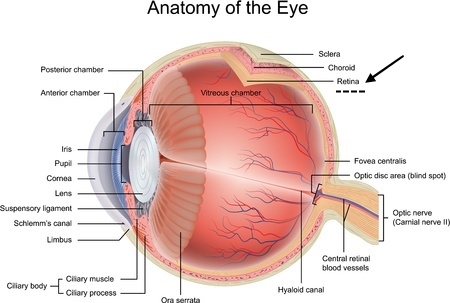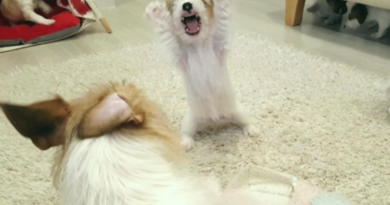Progressive Retinal Atrophy in Dogs (PRA): Causes, Symptoms, Care
Progressive Retinal Atrophy by Janice Jones |Updated 12-14-2022
Progressive
Retinal Atrophy (PRA) occurs in many dog breeds and is a non-painful
genetic
disease of the retina in the eye that leads to blindness.
PRA is not
one disease, but a group of them that include dysplastic (abnormal
development), dystrophic (loss of cells) or degenerative disease
(deterioration)
of the retinal cells.
 Progressive Retinal Atrophy has been identified as having occurred in the Tibetan Terrier among other small dog breeds.
Progressive Retinal Atrophy has been identified as having occurred in the Tibetan Terrier among other small dog breeds.The Retina of the Eye
A quick anatomy lesson…
 Notice Where the Retina of the Eye is located at the back of the eye structure.
Notice Where the Retina of the Eye is located at the back of the eye structure.Before we
can understand how all this happens, we need to do a mini review of the retina’s
function. The retina is located at the back of the eye where it
receives light coming through.
Before
the digital age, experts described the retina as the film in the camera. A chemical reaction occurs there that causes a
nerve impulse. That impulse passes
through to the optic nerve where it goes to the brain. Vision takes place in the brain.
As you can
see, the eye is just an organ that collects light and focuses the light rays
onto the retina. Without the work of the
retina, light cannot be converted to real vision.
The retina
contains two types of cells, the rods,
and the cones. Rods are involved in the
black and white or night vision. Cones
are involved in day vision or color.
Progressive Retinal Atrophy affects
either the rods alone or both together. As the rods
begin to die, the dog’s vision diminishes first in dim light (aka night
blindness or poor vision in the dark).
As the disease progresses, cones die off resulting in all the areas
becoming affected until the dog is blind.
In PRA, the
cells are programmed to die because it
is an inherited disorder. For most dog breeds
and mixes, the mode of transmission from parent to a child requires recessive genes.
Most forms of PRA involve an autosomal recessive trait.
Progressive Retinal Atrophy Takes Many Forms
As mentioned above, PRA is not one single disease but includes many each of which affects the retina in different ways and is inherited in dissimilar ways.
Generalized
The most common
type is Generalized Progressive Retinal Atrophy and it causes
atrophy or death to all rods and cones.
Generalized PRA can be dysplastic where the rods and cones develop in an
abnormal way. In the degenerative form of Generalized PRA, the rods
and cones develop normally but then change and die.
Generalized
PRA can affect breeds such as the Akita, the miniature long haired Dachshund, Papillon, Tibetan Spaniel, Tibetan Terrier and Samoyed.
Rod-cone
dysplasia
Another form of PRA, Rod Cone Dysplasia is caused by a defect in the gene for cGMP-
phosphodiesterase. It is considered an
early onset type and has been identified
in Irish Setter, Collie, Sloughi and Cardigan
Welsh Corgi.
The average age of onset and how fast the disease
progresses varies from one breed to the next.
The median age of onset is about
six to eight years.
Progressive Rod-Cone Degeration (PRCD)
This type of progressive retinal atrophy involves rods and
cones that initially develop normally but then the rods degenerate
followed by the cone cells.
This is a disease with normal rod and cone
cell development but late onset degeneration of the rod cells that
progresses
to the cone cells. It is inherited as an
autosomal recessive trait and there is a
DNA test for this type of PRA available for
some breeds.
Breeds
affected include the English and American Cocker Spaniel, Chinese Crested, Labrador
Retriever, Portuguese Water Dog, Chesapeake Bay Retriever, Australian Cattle
Dog, American Eskimo Dog, Entlebucher Mountain Dog, Finnish Lapphund,
Golden Retriever, Lapponian Herder, Miniature and Toy Poodle, Swedish Lapphund,
and
the Nova Scotia Duck Tolling Retriever.
Photoreceptor Dysplasia
This
PRA is caused by abnormal development of both the rods and cones cells resulting in night blindness initially and the progressing onto blindness during the day.
Breeds affected include the Miniature Schnauzer and Belgian Shepherd Dog. In the latter, puppies can be blinded by the age of 8 weeks.
Cataracts
It is not
uncommon to have cataracts form as the retina degenerates. This may be the first signs of the disease
observed by the dog’s owner.
Unfortunately,
once cataracts have developed, it is more difficult for the veterinarian to visualize
the retina and diagnose progressive retinal atrophy.
Cataracts are removable
through surgery, but even then, their removal will
not bring back vision if the dog also has PRA
How is PRA Diagnosed?
In the early
stages, people may not be aware of the problem.
The progression can be akin to the dimming
switch. As the lights are slowly dimmed in the room, your eyes adjust
and may not notice it until total darkness occurs. Think about the experience in a movie
theater.
Dogs rely
more on other senses such as smell and hearing and may use those even more so
as their vision dims.
Most dogs
that are diagnosed with Progressive Retinal Atrophy have been afflicted for quite awhile. Sometimes they are diagnosed during their
yearly check up. A general vet may
notice some changes in the eye while observing with an ophthalmoscope. They will then
make a referral to a veterinary ophthalmologist.
The only way
to diagnose PRA is through eye exams done by a veterinarian. Your general vet will likely refer you to a specialized
veterinary ophthalmologist.
The eye
specialist will use an electroretinogram
(ERG) to measure the retina’s ability to respond to light. The exam involves
placing an electrode on the dog’s cornea and two electrodes are placed under
the skin around the eye.
The ERG is
similar to an electrocardiogram because they both measure electrical impulses. Just as the ECG creates a characteristic wave
pattern as it measures the heart, the ERG
creates a pattern that can even diagnose dogs before they have full-blown
clinical signs.
Some dogs
may need full anesthesia while others just need sedation. There is a little risk to the procedure
including an infection or corneal ulceration.
Treatment
PRA affects
both eyes and will eventually end in
blindness. There is no way to reverse or
treat the degeneration that causes blindness.
While there is no cure, there are now tests that can be performed on
breeding animals that will help breeders make informed decisions on
which dogs to mate to help prevent PRA from being transferred to the
offspring.
Prevention of Progressive Retinal Atrophy
The only way
to avoid the problems lies in the hands
of breeders.
Eye Exams
Dogs that
are intended for breeding can be examined
by a veterinary ophthalmologist and the
results sent to the Orthopedic Foundation of America (OFA) formally the Canine
Eye Registry Foundation (CERF).
Eye
exams can be done once a year and dogs that are found to have PRA should not be bred.
Unfortunately, in some breeds, the age of onset of PRA is six to eight
years of age.
Many breeding dogs are
either being retired or have already been retired by this age, so they very
well may have passed on the disease to their offspring before the onset of the
disease in themselves.
DNA or Genetic Testing
A rcd4 mutation that
causes late onset (10 years old and older) has been
identified in Setters (Gordon, Irish,
and English), Australian Cattle Dogs, Polish Lowland Sheepdogs, Small
Munsterlanders, and Tibetan Terriers. Tests results will show whether the dog is clear,
a carrier, or is affected.
Another type of PRA, prcdPRA (prcd”
stands for “progressive rod-cone degeneration) has a genetic test offered by
Optigen.
Breeds where this test is available include: American Eskimo, Australian Stumpy Tail Cattle Dog, Australian Cattle Dog, Chinese Crested, Entlebucher Mountain Dog, Finnish Lapphund, Golden Retriever, Lapponian Herder, Miniature and Toy Poodle, Nova Scotia Duck Tolling Retriever, Swedish Lapphund.
Blindness in Dogs
While blindness
may seem very scary to people, dogs adjust very well to their gradual loss of
vision. There is no pain, and they begin to use their other senses
to get the same information that they used to when they had sight. As long as their environment remains
unchanged, they get along fine.
As owners, we want the best for our pets. There have been many advancements in genetic research, and one would expect this trend to
continue.
While there is no cure for Progressive Retinal Atrophy
at this time, there is hope that
eventually the problem will resolve
itself through excellent breeding practices.
At the same time, PRA is not life threatening,
and many blind dogs live long happy lives.
Does This Article Deserve Your Thumbs Up?
We always appreciate your support and encouragement. Your thumbs up means so much to us. Please like this article.
If you find this page or any page on Small Dog Place Helpful, or Useful in anyway, I’d love it if you would click the small heart found on the bottom right of each page.
You can also share or bookmark this page — just click on the:

Free Monthly Newsletter
Sign Up for Our Free Newsletter and get our Free Gift to You.
my E-book, The Top 10 Mistakes People Make When Choosing a Dog (and how to avoid them)




